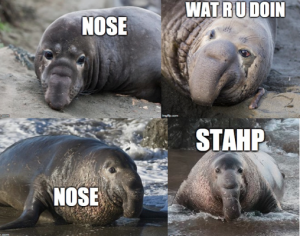What do elephant seals and Darth Vader have in common?
Other than both of them commanding your intimidation and awe, invoking both a little fear and respect at the same time, the simple answer is that they both use cool voice changers to make themselves sound more intimidating.

As they grow, male elephant seals noses elongate to give them their characteristic schnoz from which they gets their name. With this unusual-looking nose they are able to make booming noises used establish dominance and territory during breeding season. Although the main form for establishing who is the beach master and alpha male is through physical fights, they also do this vocally by scaring off other males with a several deep noises called clap-threats.
A male elephant seal will reach puberty at around 7 years and its nose will start to grow. And grow. And grow.

Once he reaches maturity he is fully equipped with a large, inflatable proboscis and is set to go fight some other males to establish dominance and get the ladies.
But how exactly does this fancy (ugly) proboscis work? The proboscis is a secondary sexual trait, which extends and inflates when it is being used to make vocalizations. As air passes through the proboscis, it vibrates and the resonances in the proboscis diverticula alters the sounds. Actually, the size of the proboscis and therefore the vocal tract size affects the acoustics of the vocalizations, and is also correlated with body size. Elephant seals also exhibit seasonal variation in the size of their proboscis, where it is the largest during breeding season.
The clap threat is the most distinct and the most intense of the vocalizations of the elephant seals. The male will raise his chest and throw his head back, with an inflated proboscis extending all the way down into the open mouth. As air passes through the proboscis he makes a loud, sharp clapping sound (hence the name). This is used to signal an attack, and when coming from the dominant male is usually enough to send all the other males running away from the females. Even males whom the threat was not directed to will scurry away.
Watch the clap threat in the video below (although you may also enjoy the clips of the seal blubber bouncing away).
Maybe if Darth Vader had used his voice changer in the same way as elephant seals, he could have had a more successful love life.
Side/end note: The elephant seal proboscis has actually inspired several different audio devices such as micro-devices for amplifying or dampening sound waves, amplification applications for hearing aids, and wireless device signal amplification.
References
George A. Bartholomew, Nicholas E. Collias, The role of vocalization in the social behaviour of the northern elephant seal, Animal Behaviour, Volume 10, Issues 1–2, January–April 1962, Pages 7-8,IN3-IN4,10-14, ISSN 0003-3472, http://dx.doi.org/10.1016/0003-3472(62)90124-0.
http://www.asknature.org/strategy/ddba038001a129f0f7127a255df0b8e1


